Positive Health Online
Your Country

Dietary Seaweed in Preventive Health
listed in nutraceuticals, originally published in issue 230 - May 2016
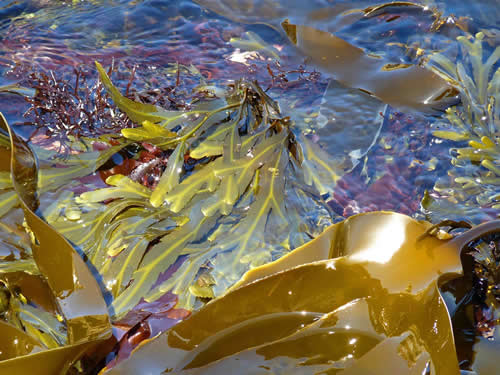
Seagreens® Wild Wrack species, Outer Hebrides, May harvest 2011. © Seagreens Trust, all rights reserved
International Research Findings
An important, 18 page scientific review was published in the international peer-reviewed journal Phycologia in November, 2015.[1] The authors, two Canadians and a Danish scientist, are widely published in marine biology, phycology (seaweed botany) and molecular biophysics. The Dane, Professor Ole Mouritsen, is the author of Seaweeds: Edible, Available & Sustainable, one of the best books on seaweed ever published (2013). Their review covers many years of nutrition research, on no less than 35 seaweed species from at least 8 countries around the world. Based on the research findings, the authors conclude that many kinds of macro algae (large seaweed species), if incorporated into our daily diet, could ameliorate risk factors which lead to cardiovascular disease - and in doing so, address many other pathologies - for example, of obesity, diabetes and hypertension.
Cardiovascular disease is still the main cause of death in Europe with a £3 billion cost to the British NHS alone. On current trends by 2035 75% of the UK population could be overweight and 41% of adults obese, leading to millions of new cases of diabetes and heart disease and getting on for a million additional cancers. The authors point to endothelial dysfunction (such as damage to the lining of the digestive tract, lymphatic and blood vessels, and the heart), cellular inflammation, and disproportionate cellular free radical production, as specific conditions which seaweeds could help prevent and alleviate.
Recent Studies in Britain
The Phycologia review looks back over two decades of international research, but quite independently, seaweed nutrition research over the past 7 years at a number of British universities, has followed a remarkably similar trajectory. Studies conducted in Ireland but not included in the review, also support its findings. Yet much of the international research focuses not on the dietary use of whole food seaweed, but on ‘bio-actives’ studied in isolation - substances, nutrient groups or nutrients in seaweeds - for use either as ‘nutraceuticals’ (foods often formulated with a medicinal benefit), or components extracted from seaweed, such as its polysaccharides (special sugars), which have been shown to have specific functionality, for example to inhibit cancer growth or increase dietary fibre.
Many of the species studied are also from places unlikely to produce seaweed that is safe for human consumption - such as China, Malaysia and the Persian Gulf. Others, such as the Enteromorpha, Gracilaria, or Ulva species, are not plentiful or cheap enough to make a real impact on population health without significant developments in cultivation technologies. Cultivation is still in its infancy. But the British research has been conducted on whole food seaweed, in a limited number of wild species, which are at once abundant around our north Atlantic shores, and relatively inexpensive to produce.
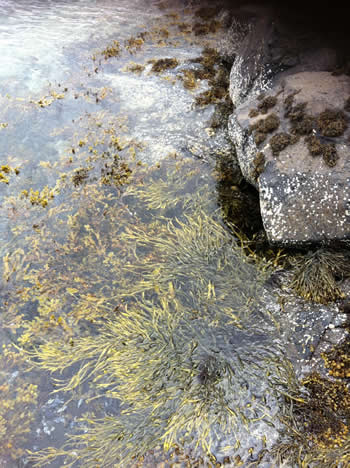
3 species of wild Wrack, Scottish Outer Hebrides 2010. © Seagreens Trust, all rights reserved
These are the wild Wrack species, with common names like Bladderwrack, Knotted Wrack, Channeled Wrack, and Spiral Wrack. They are neither the most delicate nor tasty, nor the prettiest seaweeds. But their sustainable, organic production for nutritional therapy and as food ingredients has been pioneered over the past 18 years by the Seagreens® Trust and they are already in wide use in more than a dozen countries.
Mineral Rich Salt Reduction
Such was the uniqueness of Seagreens’ food ingredients from its early years in Norway (since 2009 it has also harvested seaweed in Scotland), that by 2008 the company was selected for a major UK-government sponsored project at the Centre for Food Innovation at Sheffield Hallam University, set up in conjunction with the major supermarkets to find natural alternatives to sugars, fats - and salt. Whereas common salt, widely used in food production is about 40% sodium, 60% chloride, and no potassium (unrefined sea salt may contain up to 2% trace minerals), Seagreens’ Wrack species contain only about 3% sodium with an outstanding balance of all the minerals including potassium.
The Seagreens® species - the Knotted Wrack Ascophyllum nodosum, Bladder and Spiral Wrack Fucus vesiculosus and serratus, and Channelled Wrack Pelvetia canaliculata - proved to be highly alkalizing, naturally inhibiting the growth of pathogenic bacteria.
As a result, they proved to be at least as good a preservative as salt, and based on existing knowledge, if enough seaweed could be introduced into a variety of daily foods including our daily bread, a range of nutritional benefits should accrue through daily dietary use.

Dried Wrack species prepared as a raw food in pieces and in large and small granules for everyday use
- in the tradition of European coastal communities.
Manufactured bread alone can be responsible for 3/4 of excess dietary sodium. At the time, the British government was funding a public awareness campaign for heart health, and the supermarkets were vying to demonstrate lower levels of salt. The Food Standards Agency and the academic charity Consensus Action on Salt and Health (CASH) were calling to reduce salt intake by a third from 9 to 6 grams per day - less than 4g in a family loaf. This remains to be achieved.
Across all the tests for food safety, shelf life, functionality and organoleptics, the Seagreens research found it possible to replace up to 5 grams of salt in bread and meat products with dried granulated seaweed. A triumph for cardiovascular health, this paved the way for a series of studies to explore its possible benefits in related pathologies.
Nutrient Powerhouse to Complement Land Foods
5 grams of seaweed (a generous teaspoon) turns out to be a significant statistic, because 4.6 grams per person per day is the amount of seaweed estimated in the traditional Japanese diet - reputedly the world’s healthiest. A Japanese study as long ago as 1986 showed that an equal blend of seaweed and salt could be an antidote to excess sodium.[2]
Between 2009-15, independent studies on Seagreens® at Dublin, Glasgow, Leeds, Newcastle, Sheffield, and Teeside universities have lent detailed support to the main thrust of the argument put forward in the Phycologia review.
Nutritionally, the Wrack species are mineral rich, nutrient dense whole foods with a broader balance of all the nutrients than most of some 10,000 edible seaweeds worldwide.
The Phycologia authors describe “the mineral and trace element content of wild Bladder Wrack Fucus vesiculosus, wild Kelp Laminaria digitata, and wild Wakame Undaria pinnifitada, wild Carragheen Chondrus crispus, and wild Laver Porphyra tenera" as “more than adequate to meet (dietary) nutritional demands, even as relative proportions (which) varied among species”. A 2-year independent comparative nutrition study of Seagreens® species at Sheffield Hallam University in 2011-12 was the largest ever undertaken on the wild Wrack species. The significant loss of minerals in our agricultural soils and foods recorded over 50 years from 1940-91[3] is well matched and can be ‘adequately’ replaced by these sea vegetables.
| www.seagreens.co.uk/nutrition provides a comprehensive nutritional profile for each Seagreens® daily dietary product, plus an on-line calculator so you can see how much of any given nutrient there will be in any given amount of the seaweed. |
Their vitamin composition, if produced to a high standard and not denatured, is equally broad and unusual. The vitamin E has all the isomers usually found in grains like wheat germ - a gluten-free replacement.
Seagreens® were found to have vitamin K, essential for wound healing, the sunshine vitamin D (neither of which are in fruits or vegetables), H (biotin or B7, best sources peanuts and almonds), and the whole B complex (including B12, best sources meat and milk). So not only do Seagreens® complement a land food diet; they can replace often allergenic conventional sources, and they are certified allergen-free.
They are a particularly well-balanced source of polyunsaturated fatty acids leading the Phycologia authors to conclude “there is compelling evidence that marine sources of Omega 3, administered as food or supplements for at least 6 months, can reduce cardiovascular events by 10%, cardiac death by 9%, and coronary events by 18%”.
Wrack seaweeds also contribute the rare ‘umami’ flavour to foods which largely enabled the Japanese to relish their diet of “predominantly low-calorie, high-fibre vegetables, seaweeds and fruits” - due to high levels of natural glutamate, which contributes to brain health.
In a recent study of the elderly, Umami has been shown to stimulate salivation and taste, helping them to regain appetite, weight and overall health.[4]
| “Many of my patients are on restricted diets, and they often complain that the food is ‘bland’ and lacking flavour. By using the Seagreens® condiments they will still be able to enjoy a flavoursome diet” - Helen Heap, Nutritionist, Women's Nutritional Advisory Service (dietary advisory service specializing in PMS, the Menopause, and IBS), England, April 1999. |
A Nutritious Whole Food that Reduces Weight
When Seagreens® was given to overweight subjects in a breakfast of scrambled eggs on toast in an award-winning 2009 study,[5] they consumed 179 less calories during the day following their seaweed-enriched meal, with no adverse effect on nutrient uptake. 100 less calories is sufficient to achieve weight loss. Their breakfast contained 16 grams of Seagreens®, more than 4 times that needed to replace all the salt, but none of the subjects could tell the difference against ordinary toast. In consumer studies up to 20 grams was still acceptable.
Seagreens has long advocated the same diverse approach to the dietary use of seaweed proposed by the Phycologia authors, aiming to deliver a few grams across a varied diet on a daily basis: “small amounts consumed in a variety of ways would be an optimal approach, especially for those not already accustomed to eating macro algae”.
A gram of Seagreens® added into almost any food was the founding aim of the company in 1997.
The seaweed has another valuable trick up its sleeve. Toxins are stored in fat, so fat reduction releases toxins into the blood. The antioxidant, mineral and polysaccharide content of the seaweed helps excrete toxins - a phenomenon well known to nutritional therapists who often have to pick up the pieces from weight loss dieting.
The Wrack seaweed contains more dietary fibre than wholemeal bread - and this is soluble fibre, which promotes fermentation in the gut and more gradual nutrient absorption, leading both to reduced hunger and weight, while the high nutritional value of the seaweed must help reduce food craving - the antithesis of fast food.
Naturally Prebiotic, Reduces Glycaemic Index
In separate prebiotic and nutrition studies Seagreens® was found to increase good gut bacteria (Lactobacilli) and decrease bad bacteria (E. coli). Unusually high levels of polyphenols and antioxidants were found - even more than antioxidant land foods like green tea.
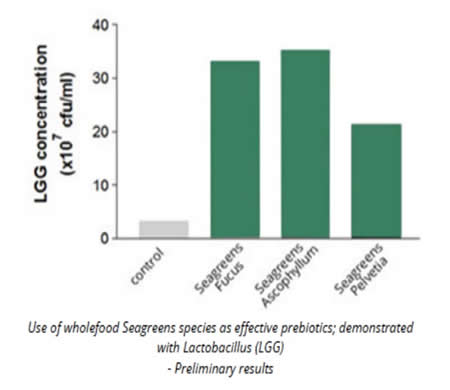
Table 1: A Teeside University study confirmed Seagreens® an effective prebiotic. © Seagreens Trust, all rights reserved
The phenols inhibit starch digestive enzymes, further slowing the release of sugars to the blood - similar to eating low glycaemic foods like whole brown rice. The soluble fibre is of many kinds of polysaccharides, more numerous but similar to those in land foods like aloe vera, and readily colonised by good bacteria in the gut. Dietary fibre in Fucus vesiculosus is 59.12% compared to 42.7% in wheat bran (most of which is insoluble, passing through the gut undigested).
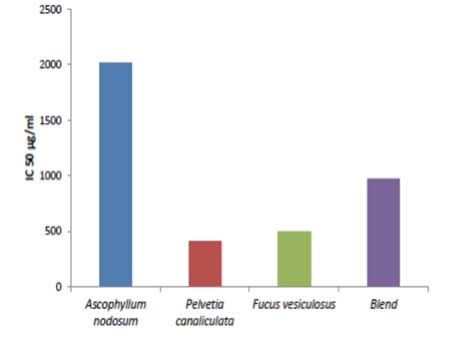
Table 2: Different levels of inhibition of digestive enzymes are shown between Seagreens® Wrack species in nutrition studies at Sheffield Hallam University. © Seagreens Trust, all rights reserved
This fermentation in the gut is valuable. It was found to cause the gradual release not only of sugars, but of the soluble minerals like iodine, of which Seagreens® has been shown to be an ideal source.[7] The high antioxidant capacity survived initial digestion meaning that the seaweed could protect against oxidative damage (free radicals) in the gut,[8] probably reducing oxidative stress by improving the balance of nitric oxide and reactive oxygen species (ROS).

Table 3: Comparison of Seagreens® antioxidant capacity after enzymatic digestion measured by FRAP assay 2012, Newcastle University. Fruit and vegetable data, Nagah and Seal, 2005.
These nutritional effects of the seaweed could help resolve hypertension and endothelial dysfunction. Just as the right kind of fibre will influence carbohydrate metabolism, antioxidants assist in the breakdown of fats. Lipid sensing in the gut and brain is a normal metabolic strategy to balance energy intake and energy use, by triggering energy and glucose regulation. Such metabolic homeostasis deteriorates when the body is consistently overwhelmed by prolonged exposure to excess calories, fats and sugars, and produces a range of stress responses. These include oxidative and inflammatory responses which can soon lead to cellular dysfunction and vascular disease, and then to diabetes and obesity.
These studies at Glasgow, Newcastle, and Teeside Universities have established the potential of these Wrack species in the prevention and treatment of obesity and diabetes.
Iodine and Broad Mineral Sufficiency
Sea vegetables are the only vegetable source of natural iodine, normally obtained from fish and dairy foods. Upper tolerable limits are set in the EU at 600µg and in the USA at 1100µg iodine per person per day, and it is estimated that 66% of adult women and 76% of school aged girls in the UK may be iodine-deficient. Iodine contributes to normal thyroid, nervous system and cognitive function, the normal growth of children, normal energy-yielding metabolism, and the maintenance of normal skin. Animal and human studies also indicate that iodine may be preventative in fibrocystic disease of the breast and breast cancer.[9]
In a Glasgow University study of Seagreens® Ascophyllum in capsules produced by Napiers,[7] prolonged uptake of soluble iodine from the seaweed was demonstrably healthier than the rapid uptake and decline of manufactured potassium iodide, a manufactured iodine supplement widely used in salt.
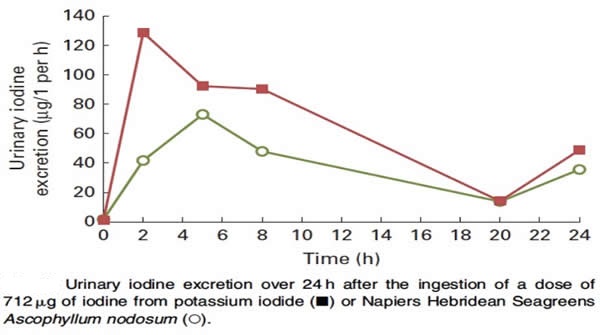
Table 4: Prolonged uptake of soluble iodine from the seaweed was demonstrably healthier than the rapid uptake and decline of potassium iodide, a manufactured supplement widely used in salt.
500mg Seagreens® Ascophyllum per day, containing approximately 350µg iodine of which about a third would normally be absorbed, improved intake by 60% in iodine-insufficient women, with no adverse effect on thyroid hormones or function.
Growing Interest, Growing Industry
Based on historical as well as the latest research, and because it is widely available in ingredient forms which are easy to use in all kinds of everyday foods, Seagreens® Wrack seaweed is ideal as a nutrient dense, mineral rich, natural whole food, which by very minimal inclusion in the daily diet, can deliver iodine sufficiency with no adverse effect on thyroid function, reduce the glycaemic response to carbohydrate load, reduce hunger via lowered gastric emptying with a positive effect on nutrition, and in the digestion is an effective prebiotic, and a high antioxidant free radical scavenger. It is a source of comprehensive nutrition which may help to ameliorate numerous risk factors associated with diabetes, obesity, endothelial dysfunction, hypertension and cardiovascular disease, and at the same time enhance the nutritional value of any limited or special diet.
In an ideal world a wider variety of sea vegetables would add culinary, if not more nutritional, interest, and new food quality seaweed producers are emerging in Cornwall, Denmark, Iceland, Norway, Scotland and elsewhere. Consumer interest in seaweed has grown substantially; media coverage grew 100% between 1998-2012, and in the same period scientific research increased 175%.[10]
Yet although other species are available mainly from artisan producers around the world (particularly from Japan) of some 35 seaweed species identified in the Phycologia international review, only a handful have certified allergen and contaminant free nutritional profiles, comply with international food safety regulations, and have been subject to sustained scientific research.
To improve consumer choice and quality assurance in Europe, the Seagreens® Trust is working with the Seaweed Health Foundation, the Biodynamic Association, seaweed producers and other organisations to introduce Nutritious Food Seaweed, a new voluntary international standard which will enable consumers to identify sustainable seaweed of outstanding nutritional quality.
References
1. Cornish M. L., Critchley A. T., and Mouritsen O. G. A role for dietary
macroalgae in the amelioration of certain risk factors associated with cardiovascular
disease. Phycologia, Volume 54 (6), 649-666. 2015.
2. Yamori Y. et al. Dietary prevention of stroke and its mechanisms in stroke-prone spontaneously hypertensive rats - preventive effect of dietary fibre and palmitloleic acid. Journal of Hypertension 4 (3):S449-S452). 1986.
3. Thomas D. The Mineral Depletion of foods available to us as a nation (1940 - 2002). A Review of the 6th Edition of McCance and Widdowson, based on a review of the 5th Edition of McCance & Widdowson’s The Composition of Foods. 2007.
4. Sasano T., Shizuko Satoh-Kuriwada S., and Noriaki Shoji N. (Division of Oral Diagnosis, Department of Oral Medicine and Surgery, Tohoku University Graduate School of Dentistry, 4-1 Seiryo-machi, Aoba-ku, Sendai 980-8575, Japan). The important role of umami taste in oral and overall health. Flavour, 4: 10. 2015.
5. Hall A. C., Fairclough A. C., Mahadevan K., and Paxman J, R. Ascophyllum nodosum enriched bread reduces subsequent energy intake with no effect on post-prandial glucose and cholesterol in healthy, overweight males. Journal of Appetite, 58: 379-386. 2012,
6. Lyons V. Seagreens® as a potential prebiotic and the role of prebiotic bacteria in the production of nitric oxide in macrophages. MSc thesis, Teeside University. 2012.
7. Combet E., Feei Ma Z., Cousins F., Thompson B, and Lean M. E. J. Low-level seaweed supplementation improves iodine status in iodine-insufficient women. British Journal of Nutrition. 2014.
8. Wheater H. Please of polyphenols from brown seaweed following in vitro enzymatic digestion. MSc thesis, Newcastle University. 2012.
9. Brownstein D. Iodine - high doses treat the thyroid, breast disease and cancer, Caduceus, Issue 75, pp18-21. 2008.
10. Seaweed Health Foundation 2012 research data: available upon request. Simon Green, Founder. 2012.
Comments:
-
Dr M Ranger said..
What a superb article. Mainstream medicine needs more of this.